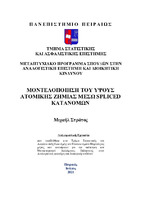Μοντελοποίηση του ύψους ατομικής ζημιάς μέσω spliced κατανομών

View/
Keywords
Ύψος ατομικής ζημιάς ; Συγκολλημένη κατανομήAbstract
In some cases, during the modelling process of the loss payments we observe that in some ranges the loss amounts seem to display high frequency – low severity while in other ranges they show low frequency – high severity. In order to propose a proper way to model the claims special behaviour we present the concept of spliced distributions, which means a probabilistic model that derives from the combination of n- fat tail distributions, n≥2, and it is applied in situations that the common loss distributions fail to provide the expected outcomes. The initial definition was given by Cooray – Ananda (2005) but the research regarding the spliced distributions is based on the more general definition of Scollnik (2007). The definition of the new models will be presented and the case of two components will be studied (n=2). Thereafter, the spliced distributions Lognormal – Pareto (Scollnik, 2007), Lognormal – GPD (Scollnik, 2007), Weibull – GPD (Scollnik – Sun, 2012) and Gamma – GPD (Teodorescu – Vernic, 2013) will be analyzed. The analytical expressions for the calculation of the moments as well as the basic risk measures will be given. For the derivation of the maximum likelihood estimators the statistical software R will be used. Also, a simulation study will be conducted in order to assess the estimator’s quality. Finally, two applications of spliced distributions on real data sets will be presented.


